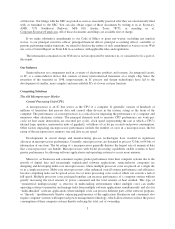AMD 2013 Annual Report Download - page 19
Download and view the complete annual report
Please find page 19 of the 2013 AMD annual report below. You can navigate through the pages in the report by either clicking on the pages listed below, or by using the keyword search tool below to find specific information within the annual report.Intel exerts substantial influence over computer manufacturers and their channels of distribution through
various brand and other marketing programs. As a result of Intel’s dominant position in the microprocessor
market, Intel has been able to control x86 microprocessor and computer system standards and benchmarks and to
dictate the type of products the microprocessor market requires of us. Intel also dominates the computer system
platform, which includes core logic chipsets, graphics chips, motherboards and other components necessary to
assemble a computer system. OEMs that purchase microprocessors for computer systems are highly dependent
on Intel, less innovative on their own and, to a large extent, are distributors of Intel technology. Additionally,
Intel is able to drive de facto standards for x86 microprocessors that could cause us and other companies to have
delayed access to such standards.
Intel has substantially greater financial resources than we do and accordingly spends substantially greater
amounts on marketing and research and development than we do. We expect Intel to maintain its dominant
position and to continue to invest heavily in marketing, research and development, new manufacturing facilities
and other technology companies. To the extent Intel manufactures a significantly larger portion of its
microprocessor products using more advanced process technologies, or introduces competitive new products into
the market before we do, we may be more vulnerable to Intel’s aggressive marketing and pricing strategies for
microprocessor products. For example, Intel recently introduced microprocessors for low-cost notebooks, similar
to products that we offer for low-cost notebooks.
As long as Intel remains in this dominant position, we may be materially adversely affected by Intel’s:
• business practices, including rebating and allocation strategies and pricing actions, designed to limit our
market share and margins;
• product mix and introduction schedules;
• product bundling, marketing and merchandising strategies;
• exclusivity payments to its current and potential customers and channel partners;
• control over industry standards, PC manufacturers and other PC industry participants, including
motherboard, memory, chipset and basic input/output system, or BIOS, suppliers and software
companies as well as the graphics interface for Intel platforms; and
• marketing and advertising expenditures in support of positioning the Intel brand over the brand of its
OEM customers.
Intel’s dominant position in the microprocessor market, its introduction of competitive new products, its
existing relationships with top-tier OEMs and its aggressive marketing and pricing strategies could result in
lower unit sales and a lower average selling price for our products, which could have a material adverse effect on
us.
Other competitors include a variety of companies providing or developing ARM-based designs at relatively
low cost and low power processors for the computing market including netbooks, tablets and thin-client form
factors, as well as dense servers, set-top boxes and gaming consoles. ARM Holdings designs and licenses its
ARM architecture to third parties, including AMD, and offers supporting software and services. Our ability to
compete with companies who use ARM-based solutions depends on our ability to design energy-efficient, high-
performing products at an attractive price point.
Competition in the Chipset Market
In the chipset market, our competitors include suppliers of integrated graphics chipsets. PC manufacturers
use integrated chipsets because they cost less than traditional discrete GPUs while offering acceptable graphics
performance for most mainstream PC users. Intel also leverages its dominance in the microprocessor market to
sell its integrated graphics chipsets. Intel manufactures and sells integrated graphics chipsets bundled with their
microprocessors and is a dominant competitor in this market.
11
























